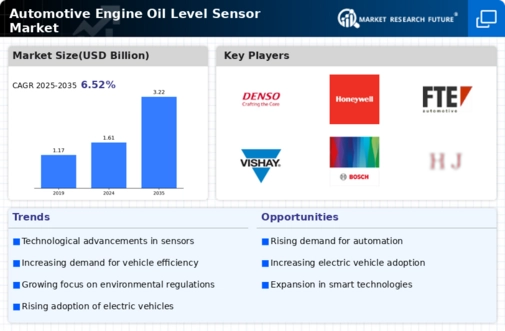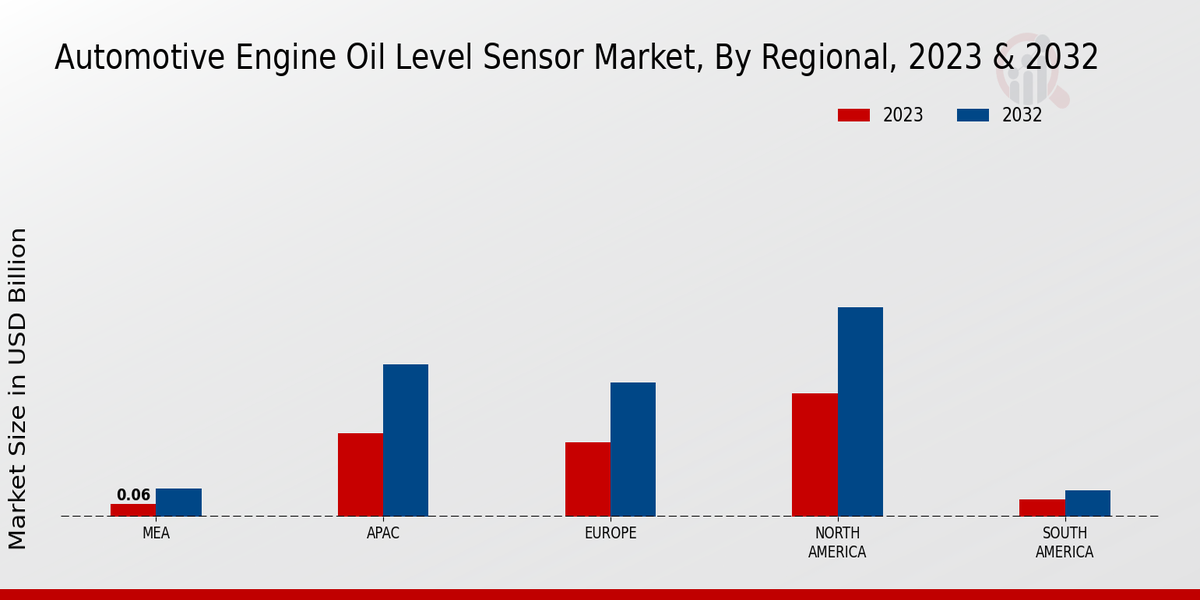Market Growth Projections
The Global Automotive Engine Oil Level Sensor Market Industry is projected to experience substantial growth over the coming years. With an anticipated market value of 1.61 USD Billion in 2024 and a forecasted increase to 3.22 USD Billion by 2035, the industry is expected to witness a compound annual growth rate of 6.49% from 2025 to 2035. This growth trajectory suggests a robust demand for oil level sensors, driven by technological advancements, regulatory pressures, and evolving consumer preferences. The market's expansion reflects the critical role that oil level sensors play in enhancing vehicle performance and compliance with environmental standards.
Stringent Emission Regulations
The Global Automotive Engine Oil Level Sensor Market Industry is significantly influenced by stringent emission regulations imposed by governments worldwide. These regulations necessitate the implementation of technologies that ensure optimal engine performance and reduced emissions. Oil level sensors play a critical role in this context, as they help maintain the appropriate oil levels, thereby minimizing harmful emissions. As regulatory bodies continue to tighten standards, manufacturers are compelled to integrate advanced oil level sensors into their vehicles. This trend is expected to drive market growth, as compliance with these regulations becomes increasingly essential for automotive manufacturers aiming to meet both local and international standards.
Rising Demand for Advanced Engine Technologies
The Global Automotive Engine Oil Level Sensor Market Industry is experiencing a surge in demand driven by the increasing adoption of advanced engine technologies. As vehicles become more sophisticated, the need for precise monitoring of engine oil levels has become paramount. This trend is particularly evident in electric and hybrid vehicles, where efficient engine performance is crucial. The market is projected to reach 1.61 USD Billion in 2024, reflecting a growing recognition of the importance of oil level sensors in maintaining optimal engine function and longevity. Such advancements not only enhance vehicle performance but also contribute to reducing emissions, aligning with global sustainability goals.
Technological Advancements in Sensor Technology
The Global Automotive Engine Oil Level Sensor Market Industry is benefiting from rapid technological advancements in sensor technology. Innovations such as improved accuracy, durability, and integration with vehicle diagnostics systems are enhancing the functionality of oil level sensors. These advancements allow for real-time monitoring and alerts, which can prevent engine damage due to low oil levels. As automotive manufacturers increasingly prioritize reliability and performance, the adoption of these advanced sensors is expected to rise. This trend is likely to contribute to a compound annual growth rate of 6.49% from 2025 to 2035, reflecting the growing importance of technology in the automotive sector.
Growth in Electric and Hybrid Vehicle Production
The Global Automotive Engine Oil Level Sensor Market Industry is poised for growth, particularly due to the rising production of electric and hybrid vehicles. These vehicles often require sophisticated monitoring systems to ensure optimal performance and efficiency. As manufacturers focus on enhancing the reliability and performance of electric drivetrains, the demand for advanced oil level sensors is likely to increase. This shift is projected to contribute to the market's expansion, with estimates suggesting a growth to 3.22 USD Billion by 2035. The integration of oil level sensors in these vehicles not only supports engine health but also aligns with the industry's shift towards sustainable transportation solutions.
Increasing Consumer Awareness of Vehicle Maintenance
The Global Automotive Engine Oil Level Sensor Market Industry is also driven by increasing consumer awareness regarding vehicle maintenance and performance. As consumers become more informed about the importance of regular oil checks and maintenance, the demand for reliable oil level sensors is likely to grow. This heightened awareness is fostering a culture of proactive vehicle care, where consumers seek vehicles equipped with advanced monitoring systems. Consequently, manufacturers are responding by integrating sophisticated oil level sensors into their designs. This trend not only enhances vehicle reliability but also aligns with consumer expectations for improved performance and longevity.























